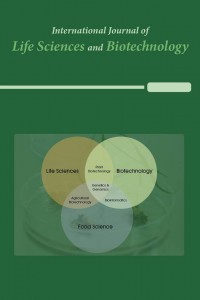Delphinidin, Luteolin and Halogenated Boroxine Modulate CAT Gene Expression in Cultured Lymphocytes
Delphinidin, Luteolin and Halogenated Boroxine Modulate CAT Gene Expression in Cultured Lymphocytes
___
- 1. Sies, H., Oxidative stress: a concept in redox biology and medicine. Redox biology, 2015. 4: p. 180–183.
- 2. Pisoschi, AM. and A. Pop, The role of antioxidants in the chemistry of oxidative stress: A review. European Journal of Medicinal Chemistry, 2015. 97: p. 55–74.
- 3. Ghezzi, P., et al., The oxidative stress theory of disease: levels of evidence and epistemological aspects. British Journal of Pharmacology, 2017. 174: p. 1784–1796.
- 4. Kodydková, J., et al., Human Catalase, Its Polymorphisms, Regulation and Changes of Its Activity in Different Diseases. Folia Biologica, 2014. 60: p. 153-167.
- 5. Gao, G., et al., Luteolin exhibits anti-breast cancer property through up-regulating miR-203. Artificial Cells, Nanomedicine, and Biotechnology, 2019. 47 (1): p. 3265-3271.
- 6. Imran, M., et al., Luteolin, a flavonoid, as an anticancer agent: A review. Biomedicine & Pharmacotherapy, 2019. 112: 108612.
- 7. Seelinger, G., et al., Anti-carcinogenic Effects of the Flavonoid Luteolin. Molecules, 2008. 13: p. 2628-2651.
- 8. Lin, Y., et al., Luteolin, a flavonoid with potentials for cancer prevention and therapy. Current Cancer Drug Targets, 2008. 8 (7): p. 634–646.
- 9. Murata, M., et al., Delphinidin Prevents Muscle Atrophy and Upregulates miR-23a Expression. Journal of Agricultural and Food Chemistry, 2017. 65 (1): p. 45-50.
- 10. Kuo, H.D., et alAnthocyanin Delphinidin Prevents Neoplastic Transformation of Mouse Skin JB6 P+ Cells: Epigenetic Re-activation of Nrf2-ARE Pathway. The AAPS Journal, 2019. 21 (5): p. 83.
- 11. Lee, D.Y., et al., Cytotoxic effects of delphinidin in human osteosarcoma cells. Acta Orthopaedica et Traumatologica Turcica, 2018. 52 (1): p. 58–64.
- 12. Ni, T., W. Yang, and Y. Xing, Protective effects of delphinidin against H2O2 induced oxidative injuries in human retinal pigment epithelial cells. Bioscience Reports, 2019. BSR20190689.
- 13. Galic, B., Removal of skin changes. European patent EP1996514, 2013.
- 14. Haverić, S., et al., Effects of dipotassium trioxohydroxytetrafluorotriborate (K2[B3O3F4OH]) on genetic material and inhibition of cell division in human cell cultures. Drug and Chemical Toxicology, 2011. 34 (3): p. 250-254.
- 15. Haveric, S., et al., Genotoxicity evaluation of dipotassium-trioxohydroxytetrafluorotriborate, K2(B3O3F4OH), in human lymphocyte cultures and mice reticulocytes. Brazilian Archives of Biology and Technology, 2016. 59: e16160195.
- 16. Marasović, M., et al., Quantum Chemical and Biochemical Study on Antioxidant Properties of Halogenated Boroxine K2[B3O3F4OH]. Croatica chemica acta, 2017. 90 (2): p. 155–161.
- 17. Islamovic, S., B. Galic, and M. Milos, A study of the inhibition of catalase by dipotassium-trioxohydroxytetrafluorotriborat K2[B3O3F4OH]. Journal of Enzyme Inhibition and Medicinal Chemistry, 2014. 29 (5): p. 744–748.
- 18. Hadzic, M., et al., Inhibitory effects of delphinidin and luteolin on genotoxicity induced by K2(B3O3F4OH) in human lymphocytes in vitro. Biologia, 2015. 70: p. 553–8.
- 19. Hadzic, M., et al., Bioflavonoids protect cells against halogenated boroxine-induced genotoxic damage by upregulation of hTERT expression. Zeitschrift fur Naturforschung. C, Journal of biosciences, .2018. 74 (5-6): p. 125-129.
- 20. Ryss, I.G., and M.M. Slutskaya, Report on the Platinum Sector. Akademia Nauka SSSR, 1951. 26: p. 216.
- 21. Pfaffl, M.W., G.W. Horgan, and L. Dempfle, Relative expression software tool (REST) for group-wise comparison and statistical analysis of relative expression results in real-time PCR. Nucleic Acids Research, 2002. 30 (9): e36.
- 22. Luca, V.S., A. Miron, and A.C. Aprotosoaie, The antigenotoxic potential of dietary flavonoids. Phytochemistry Reviews, 2016. 15 (4): p. 591-625.
- 23. Ezić, J., et al., Analysis of delphinidin and luteolin genotoxicity in human lymphocyte culture. Journal of Health Sciences, 2015. 5 (2): p. 41-45.
- 24. Azevedo, L., et al., Differential response related to genotoxicity between eggplant (Solanum melanogena) skin aqueous extract and its main purified anthocyanin (delphinidin) in vivo. Food and Chemical Toxicology, 2007. 45: p. 5852-5858.
- 25. Lazzé, M.C., et al., Anthocyanins induce cell cycle perturbations and apoptosis in different human cell lines. Carcinogenesis, 2004. 25: p. 81427-81433.
- 26. Hadžić, M., Analysis of potential of bioflavonoids (luteolin and delphinidin) in inhibition of genotoxic and cytotoxic effects of halogenated boroxine in vitro. MSc Thesis, University of Sarajevo, 2013.
- 27. Chakraborthy, A., et al., Antioxidant and pro-oxidant activity of Vitamin C in oral environment. Indian Journal of Dental Research, 2014. 25 (4): p. 499.
- 28. Chobot, V., and F. Hadacek, Exploration of pro-oxidant and antioxidant activities of the flavonoid myricetin. Redox report Communications in free radical research, 2011. 16 (6): p. 242–247.
- 29. Wang, J., et al., Antioxidant and Pro-Oxidant Activities of Melatonin in the Presence of Copper and Polyphenols In Vitro and In Vivo. Cells, 2019. 8 (8): p. 903.
- 30. Ribeiro, D., et al., Antioxidant and pro-oxidant activities of carotenoids and their oxidation products. Food and Chemical Toxicology, 2018. 120: p. 681-699.
- Yayın Aralığı: Yılda 3 Sayı
- Başlangıç: 2018
- Yayıncı: International Society of Academicians
Antarktika: Yaşam Bilimleri ve Biyoteknoloji Araştırmalarının Gözden Geçirilmesi
Suleyman Faruk KIRKINCI, Sevgi MARAKLI, Hasan Murat AKSOY, Didem ÖZÇİMEN, Yilmaz KAYA
Bitkisel Üretimde Yeni Bir Trend: Kenevir
Growth Analysis of Lactobacillus acidophilus Using Different Non-Digestible Carbohydrates
Haia Abobakr AL-KAF, Fahrul Zaman HUYOP, Noor Azwani ZAİNOL
Fatma Şayan POYRAZ, Edibe ABACI, Caner ERTÜRK, Tayfun ACAR, Serap DERMAN, Semiha ERİŞEN, Banu MANSUROĞLU
How did the Addition of Indaziflam Affect on Carbon and Nitrogen Mineralizations in a Vineyard Soil?
Burak KOÇAK, Şahin CENKSEVEN, Nacide KIZILDAĞ, Hüsniye AKA SAĞLIKER, Cengiz DARICI
Lactic Acid Bacterium With Antimicrobial Properties From Selected Malay Traditional Fermented Foods
Tengku Haziyamin TENGKU ABDUL HAMİD, Nur FATİN AMYSYA
Yield and Quality Stabilities of Waxy Maize Genotypes using Biplot Analysis
Delphinidin, Luteolin and Halogenated Boroxine Modulate CAT Gene Expression in Cultured Lymphocytes
Nikolina TOMİC, Maida HADZİC, Naida LOJO-KADRİC, Jasmin RAMİC, Lejla POJSKİC
Chukwunonso ACHİFE, Udeme JOSHUA, Jeremiah BALA, Solomon OYELEKE
